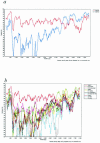Characterization of a highly evolved vaccine-derived poliovirus type 3 isolated from sewage in Estonia
- PMID: 15078968
- PMCID: PMC387693
- DOI: 10.1128/jvi.78.9.4876-4883.2004
Characterization of a highly evolved vaccine-derived poliovirus type 3 isolated from sewage in Estonia
Abstract
Two types of vaccine-derived polioviruses have been recently designated to emphasize the different origins of the evolved viruses: circulating vaccine-derived polioviruses (cVDPV) associated with outbreaks of paralytic disease and strains isolated from chronically infected immunodeficient individuals (iVDPV). We describe here a type 3 VDPV (PV3/EST/02/E252; later E252) isolated from sewage collected in Tallinn, Estonia, in October 2002. Due to aberrant properties in subtyping, the virus was subjected to detailed characterization. Partial genomic sequencing suggested that the closest relative was the oral vaccine strain PV3/Sabin, but the two virus strains shared only 86.7% of the 900 nucleotides (nt) coding for the capsid protein VP1. Phylogenetic analysis of the nearly complete genome [nt 19 to poly(A)] revealed multiple nucleotide substitutions throughout the genome and a possible Sabin 3/Sabin 1-recombination junction site in the 2C coding region. A calculation based on the estimated mutation frequency of the P1 region of polioviruses suggested that the E252 virus might have replicated in one or more individuals for approximately 10 years. No persons chronically excreting poliovirus are known in Estonia. Amino acid substitutions were seen in all known antigenic sites, which was consistent with the observed aberrant antigenic properties of the virus demonstrated by both monoclonal antibodies and human sera from vaccinated children. In spite of the apparent transmission potential, no evidence was obtained for circulation of the virus in the Estonian population.
Figures




References
-
- Balanant, J., S. Guillot, A. Candrea, F. Delpeyroux, and R. Crainic. 1991. The natural genomic variability of poliovirus analyzed by a restriction fragment length polymorphism assay. Virology 184:645-654. - PubMed
-
- Blomqvist, S., A.-L. Bruu, M. Stenvik, and T. Hovi. 2003. Characterization of a recombinant type 3/type 2 poliovirus isolated from a healthy vaccinee and containing a chimeric capsid protein VP1. J. Gen. Virol. 84:573-580. - PubMed
-
- Bottiger, M., and E. Herrstrom. 1992. Isolation of polioviruses from sewage and their characteristics: experience over two decades in Sweden. Scand. J. Infect. Dis. 24:151-155. - PubMed
-
- Buttinelli, G., V. Donati, S. Fiore, J. Marturano, A. Plebani, P. Balestri, A. R. Soresina, R. Vivarelli, F. Delpeyroux, J. Martin, and L. Fiore. 2003. Nucleotide variation in Sabin type 2 poliovirus from an immunodeficient patient with poliomyelitis. J. Gen. Virol. 84:1215-1221. - PubMed
-
- Cammack, N., A. Phillips, G. Dunn, V. Patel, and P. D. Minor. 1988. Intertypic genomic rearrangements of poliovirus strains in vaccinees. Virology 167:507-514. - PubMed
Publication types
MeSH terms
Substances
Associated data
- Actions
LinkOut - more resources
Full Text Sources
Research Materials

